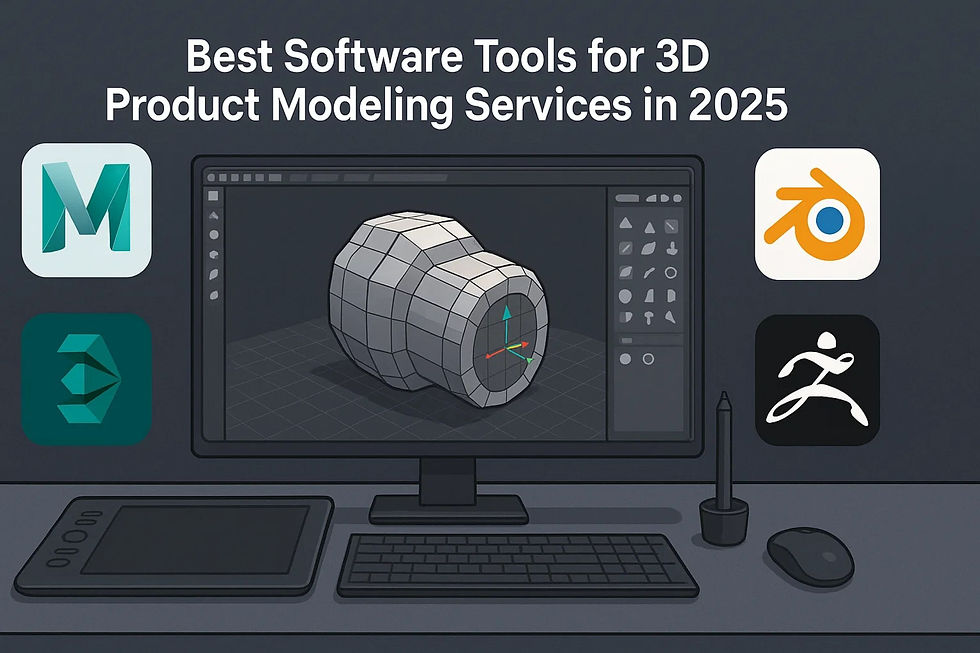The Workflow of VR 3D Modeling from Tools to Pipeline
- Hemant vizent
- Jul 21
- 4 min read

Workflow of VR 3D Modeling
Virtual reality (VR) and augmented reality (AR) have significantly transformed how we experience and interact with digital content. At the heart of this immersive revolution is VR 3D modeling, a technique that allows creators to build realistic, interactive environments and objects in three dimensions. As Virtual Reality 3D Modeling continues to gain traction, understanding the workflow behind this process becomes crucial for developers, designers, and businesses looking to leverage immersive technologies.
In this article, we’ll explore the comprehensive workflow of VR 3D modeling, highlight essential tools, break down production pipelines, and share best practices to help ensure successful project outcomes.
Importance of VR and AR 3D Modeling
Whether it's a product showcase, virtual training environment, or architectural walkthrough, the quality of 3D models directly impacts the effectiveness of the VR experience.
Similarly, AR 3D Modeling powers real-world overlays of digital objects, enabling businesses to provide AR product visualization that enhances customer engagement, especially in industries like e-commerce, automotive, and interior design.
The need for specialized 3D Modeling Services is more prominent than ever. From product modeling to 3D printing, businesses across all sectors are investing in this technology to boost innovation and efficiency.
Key Phases of the VR 3D Modeling Workflow
The VR 3D Modeling workflow can be broken down into several core stages, each essential for delivering a high-quality, immersive experience:
1. Conceptualization and Planning
This phase involves gathering requirements, defining the scope, identifying target platforms (Oculus, HTC Vive, WebXR, etc.), and deciding whether the project is for Virtual Reality 3D Modeling, AR, or both.
For example, when developing 3D product modeling services, the scope may include product dimensions, interactivity, textures, lighting, and whether the final model will be viewed in AR or VR.
2. Reference Gathering and Blueprinting
Next, artists collect reference images, blueprints, sketches, or CAD files. These references guide modelers in maintaining proportions and details, especially when creating accurate models for 3D Modeling for 3D Printing or AR Product Visualization.
High-resolution references are particularly critical for photorealistic projects, such as marketing assets or medical simulations.
3. Modeling and Sculpting
This is where the actual creation begins. The process includes:
Box modeling: Starting from simple geometric shapes.
Special attention must be given to polygon count. High-resolution models may look great, but performance constraints in VR/AR platforms often require optimization. For product visualization, artists may use 3D Model Augmented Reality workflows to ensure the object aligns well with real-world physics and proportions.
4. UV Unwrapping and Texturing
Textures should be optimized for real-time engines to ensure fast load times and low latency in VR 3D Modeling applications.
5. Rigging and Animation (If Needed)
If the model is interactive or includes movement (e.g., doors opening, character movement), rigging is required. For complex interactions, keyframe or procedural animation techniques are used.
This is especially vital in AR 3D Modeling applications where interactive storytelling and motion can dramatically enhance engagement.
6. Lighting and Scene Setup
Lighting engines like Unity’s URP or Unreal Engine’s Lumen provide tools to balance realism with performance, a crucial factor in VR and 3D model augmented reality experiences.
7. Exporting and Optimization
Exporting models in the right format (.FBX, .OBJ, .GLB, .USDZ) ensures compatibility with game engines, AR platforms, and 3D Modeling for 3D Printing systems. This is especially important for mobile AR and web-based VR experiences.
For 3D Model Maker for 3D Printer workflows, exporting must follow strict manufacturing specifications, ensuring water-tight geometry and print-friendly scaling.
8. Integration into Engine or Viewer
The final step is importing the model into a VR engine like Unity, Unreal Engine, or WebXR. Here, the model is placed within its digital context — whether a virtual showroom, training simulation, or interactive AR app.
AR Product Visualization tools such as Apple’s ARKit, Google’s ARCore, or WebAR platforms help bring these models to life across a wide range of consumer devices.
Best Practices in VR and AR
To stay competitive and produce effective 3D assets, consider these best practices:
1. Always Optimize for Performance
Whether your model is for VR, AR, or 3D Modeling for 3D Printing, lightweight assets ensure smoother experiences and faster loading times.
2. Use Physically Based Rendering (PBR)
PBR materials mimic real-world physics and lighting, making models more believable in AR and VR environments. This is particularly important for 3D Model Augmented Reality experiences where lighting conditions vary.
3. Keep Texture Sizes in Check
Large texture files can degrade performance. Use 2K or 4K textures only where needed, and implement compression methods compatible with your platform.
4. Test on Multiple Devices
VR and AR models may look different across devices. Regular testing ensures consistent quality and interaction across headsets, smartphones, or web platforms.
Real-World Applications of VR 3D Modeling
- E-commerce:
With AR Product Visualization, customers can see furniture, clothes, or gadgets in their space before purchasing.
- Manufacturing:
Models created by 3D Model Maker for 3D Printer systems streamline prototyping and product development.
Final Thoughts
By understanding its workflow, leveraging the right tools, and following best practices, creators and businesses can deliver immersive experiences that captivate, educate, and convert.
Whether you're building digital twins for AR, creating interactive training simulations in VR, or designing prototypes for 3D printing, the possibilities are limited only by your imagination — and your pipeline.





Comments